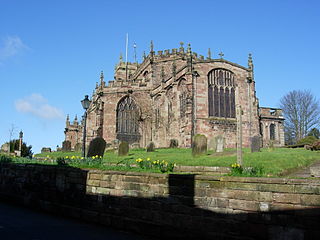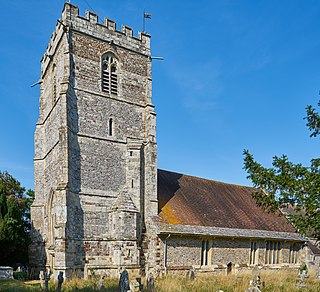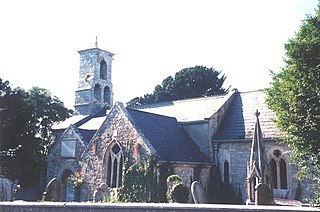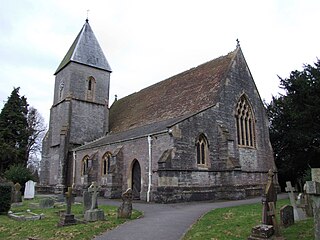
St Oswald's Church stands on the highest point in the market town of Malpas, Cheshire, England, on or near the site of a Norman motte and bailey castle. The church is recorded in the National Heritage List for England as a designated Grade I listed building and is recognised as being one of the best examples in Cheshire of a late 15th to early 16th-century church. It is an active Anglican parish church in the diocese of Chester, the archdeaconry of Chester and the deanery of Malpas. Its benefice is combined with those of St John, Threapwood, and Holy Trinity, Bickerton. Alec Clifton-Taylor includes it in his list of 'best' English parish churches.
York had around forty-five parish churches in 1300. Twenty survive, in whole or in part, a number surpassed in England only by Norwich, and twelve are currently used for worship. This article consists of, first, a list of medieval churches which still exist in whole or in part, and, second, a list of medieval churches which are known to have existed in the past but have been completely demolished.

Holy Trinity Church is a redundant Anglican church on Low Lane in the village of Wensley, North Yorkshire, England. The building is recorded in the National Heritage List for England as a designated Grade I listed building, and is under the care of the Churches Conservation Trust. Alec Clifton-Taylor included the church in his list of 'best' English parish churches.

Cranborne Priory is a former priory church in the village of Cranborne, Dorset, England. Founded in 980 as Cranborne Abbey, it became a priory in 1102, remaining that way until it was dissolved in 1540. The tower, nave and aisles from the priory survive to from the Church of St Mary and St Bartholomew, the parish church of Cranborne. The building, which has fragments from the 12th century, is designated a Grade I listed building.

Holy Trinity Church, is in the village of Bolton-le-Sands, Lancashire, England. It is an active Anglican parish church in the deanery of Tunstall, the archdeaconry of Lancaster, and the diocese of Blackburn. Its benefice is united with that of St Mark, Nether Kellett. The church is recorded in the National Heritage List for England as a designated Grade II* listed building.

The Church of St Candida and Holy Cross is an Anglican church in Whitchurch Canonicorum, Dorset, England. A Saxon church stood on the site but nothing remains of that structure. The earliest parts of the church date from the 12th century when it was rebuilt by Benedictine monks. Further major rebuilding work took place in the 13th century and in the 14th century the church's prominent tower was constructed. The church features some Norman architectural features but is predominantly Early English and Perpendicular. George Somers, founder of the colony of Bermuda, is buried under the vestry and the assassinated Bulgarian dissident Georgi Markov is interred in the churchyard. It is an active Church of England parish church in the deanery of Lyme Bay, the archdeaconry of Sherborne, and the diocese of Salisbury. It is one of only two parish churches in the country to have a shrine that contains the relics of their patron saint. The relics belong to St Candida to whom the church is dedicated. The church been designated by English Heritage as a Grade I listed building.

St Martin-cum-Gregory's Church is a Grade I listed former parish church in the Church of England in York.

St Mary Magdalene's Church, East Ham is a parish church in East Ham, east London, dedicated to St Mary Magdalene. Its nave, chancel and apse date to the first half of the 12th century and the tower probably to the early 13th century but partly rebuilt in the 16th century - it is claimed to be the oldest parish church still in weekly use in Greater London and is listed at Grade I.

St Nicholas' Church is a Church of England church in Broadwey, Dorset, England. It has Norman origins, but most of the existing church dates from 19th century work. St Nicholas' was the parish church of Broadwey until 1933 when the village became a suburb of Weymouth.

Holy Trinity Church is a Roman Catholic and former Church of England church in Dorchester, Dorset, England. Built in 1875–76 to the designs of Benjamin Ferrey, it was declared redundant by the Church of England in 1975 and reopened the following year as a Roman Catholic church. It has been a Grade II listed building since 1975.

St Laurence's Church is a Church of England parish church in Upwey, Dorset, England. Much of the existing church dates to the late 15th-century, with some earlier fabric and later additions of the 19th and 20th-centuries. It is a Grade II* listed building.

St Ann's Church is a Church of England parish church in Radipole, Weymouth, Dorset, England. The church dates to the 13th century, with later additions, and is a Grade II* listed building. Both the boundary wall of the churchyard and church room opposite are also Grade II listed.

Holy Trinity Church is a Church of England church in Walton, Somerset, England. It was rebuilt in 1865–66 to the design of Rev. J. F. Turner and is a Grade II listed building.

Holy Cross Church is a Church of England parish church in Newton Ferrers, Devon, England. The existing church has 13th-century origins, with a major restoration and rebuild of 1885–86. Holy Cross has been a Grade I listed building since 1960.

All Saints' Church is a private church, formerly belonging to the Church of England, in Mapperton, Dorset, England. The church is believed to have 12th century origins, with later additions and rebuilds. It became part of the estate of Mapperton House in 1977 and is a Grade I listed building.

Holy Trinity Church is a Church of England church in Swyre, Dorset, England. The oldest part of the church has been dated to the early 15th century, with a partial rebuild and additions later made in the 19th century. The church is a Grade I listed building.

Holy Rood Church is a former Church of England church in Coombe Keynes, Dorset, England. Most of the church dates to a rebuild of 1860–61, but the tower and chancel arch is 13th-century. It was declared redundant in 1974 and is now under the care of a charitable trust. The former church is a Grade II listed building.

St Luke's Church is a Church of England church in West Orchard, Dorset, England. Most of the church dates to a rebuild of 1876–77 to the designs of Thomas Henry Wyatt, but the chancel is 15th-century. The church is a Grade II listed building.

St Peter and St Paul's Church is a Church of England parish church in Caundle Marsh, Dorset, England. It was designed by Robert Howard Shout and built in 1856–57. The church is a Grade II listed building.

The Church of St Giles is the Church of England parish church for the village of Wimborne St Giles, Dorset. Originally founded in the 13th century and rebuilt several times over the ensuing centuries, the present church is a mixture of Georgian and Gothic Revival architecture. It is located at the start of the main driveway to St Giles House, the seat of the Earl of Shaftesbury, at the end of a row of Stuart-era almshouses.




















